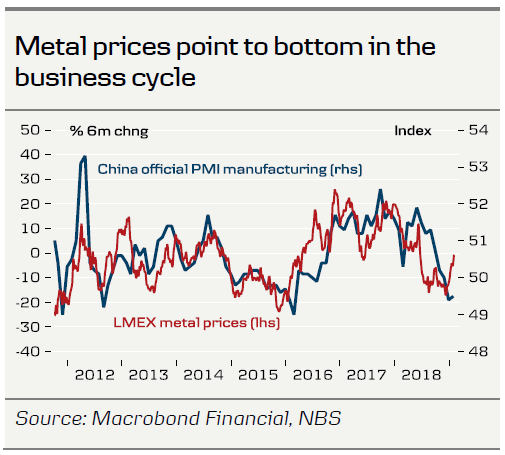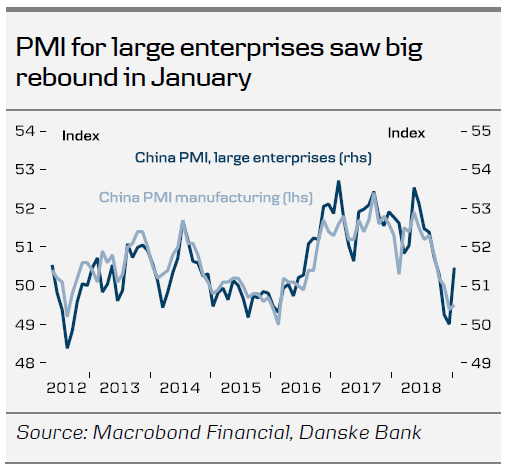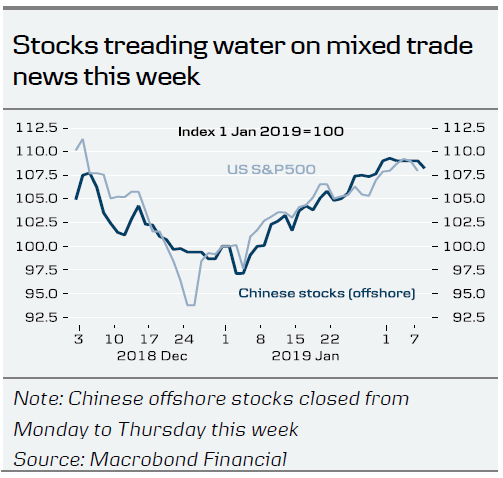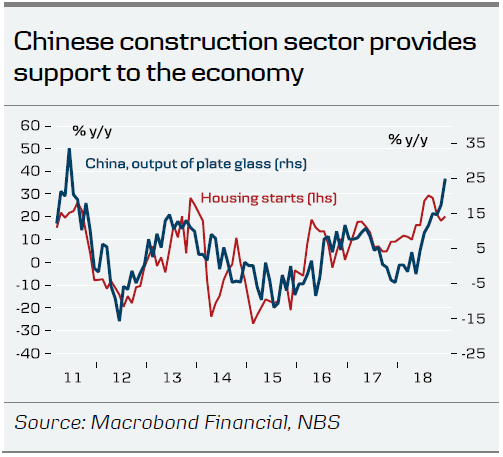- Donald Trump has changed his mind on Xi Jinping meeting after warnings from his advisers.
- Steven Mnuchin says his team is putting in an enormous effort to meet the deadline and China has made more concessions.
- Our China Leading Indicators show tentative signs of a bottom in Q1.
Note that there will be no China Weekly Letter next week due to holiday.
Newsflow this week has been on the light side, as China has been off celebrating Chinese New Year – a slightly delayed Happy New Year from our side, Below we give an overview of some of the things that did happen this week.
Advisers warn Trump off meeting with Xi this month
Most noteworthy, Trump yesterday backtracked on meeting Xi Jinping this month and even said next month was ‘ probably too soon ” to meet. This is a big change from his message last week that he might meet Xi at the end of February, when he is scheduled to meet Kim Jong-Un in Vietnam. The news rattled equity markets on fears that US tariffs will increase on 1 March (deadline of ceasefire).
Why do we see this change from Trump? According to Reuters, a person briefed on the talks said Trump’s advisers had warned him that accepting a meeting invitation at this stage would raise expectations that would be hard to meet. It could result in a sell-off in markets. According to the source, Trump was also warned that it could limit US leverage in the negotiations (see Reuters , 7 February).
US-China trade talks are set to continue early next week , as a US high-level delegation goes to Beijing. Treasury Secretary Stephen Mnuchin said on CNBC, ‘ Ambassador Lighthizer and myself and a large team are on our way to Beijing next week’ . He added ‘w e’re putting in an enormous amount of effort to try to hit this deadline and get a deal’ (see The Hill , 6 February). Trump’s economic adviser Larry Kudlow said on Thursday, ‘ The president has indicated that he’s optimistic with respect to a potential trade deal…But we’ve got a pretty sizable distance to go here’ .
According to SCMP , a senior Trump administration official said that of the 142 US demands, the number of items deemed non-negotiable by China had been sharply reduced .
Comment : What to make of this? It would seem Trump got a little carried away last week and that his advisers have made him aware that getting a deal down on paper and forming an agreement on wording in all areas will take time. Similarly, agreeing on how to make it enforceable – a key part of the trade deal – could take time.
We still believe the two sides want a deal badly enough to make ends meet eventually and that Trump and Xi will sign a deal at a meeting in coming months. However, it seems to us more likely that it will be at some point in Q2
Will tariffs go up on 1 March? We do not think so. This could cause havoc in markets and hit Trump like a boomerang. However, following the recent rally in stock markets, markets have priced in a higher probability trade deal and we should expect some volatility as the talks move closer to the finishing line, when more noise normally hits the news wires and each side tries to get the best deal possible.
More signs of economy bottoming in Q1
This week we published China Leading Indicators – First signs of a bottom, 7 February, which shows a few tentative signs of a bottom in Q1. This has been our call for some time, so there is a risk that we are a little biased here. However, we do believe it is worth highlighting that metal prices have edged up lately (see chart page 1) and both PMI new export orders and PMI for large enterprises (top chart) increased from low levels in January. Indicators for construction are also quite strong providing a floor under growth in China (chart).
Comment: It is still early days and we need more confirmation of whether we have a bottom or not. We also need to see a trade deal in Q2. However, if we are right, it would prove important for the global business cycle as China drives one-third of global growth. It would have a positive spillover to global equity markets and to development in the euro area, which has been hit by a big decline in export growth.
Financial opening speeds up
Last week, China reported that it would double the so-called QFII quota for inbound financial investments. This week, this was followed by news that China will make the QFII programme and the RQFII programme more flexible, giving investors more investment options and providing easier access (see Caixin Global (paywall), 1 February). The two programmes allow foreign institutional investors to invest in the Chinese stock and bond markets. The new rules will ‘promote high-quality opening of China’s capital markets and introduce more long-term overseas capital’, said the securities regulator CSRC in a statement.
Comment: This is yet another step of many over the past few years to open up China more for inbound investments. On top of increasing quotas in the QFII/RQFII programmes, China has opened up the stock and bond connect programmes that go through Hong Kong and has increased flexibility in investing in Chinese financial assets. This is part of a long-term plan to open the way more for both financial and real investments. The gradual opening up of the capital account also fits into the plan of internationalisation of the CNY. However, increasing invoicing in CNY will also be crucial in this respect.
Other news of the week
Trump is set to sign an executive order banning Chinese telecom equipment next week (see Politico 7, February). However, both Germany and Italy said this week that they would not exclude Huawei from 5G buildout (see Reuters, 7 February).
However, Germany is launching a new industrial strategy to protect and create its own ‘National Champions’ in the area of technology (see Politico, 7 February). This is part of a new global trend to protect and support national tech sectors, as China has increasingly entered the scene in global tech using the industrial policy of ‘Made in China 2025’.
At a micro level, you can read about how DJI went from university dorm project to the world’s biggest drone company (see SCMP, 5 February). This is an impressive story of how one of China’s young entrepreneurs founded the world’s biggest drone company 15 years ago.


















